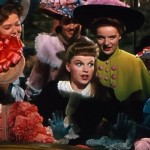After working as an uncredited associate producer on The Wizard of Oz, Arthur Freed was given charge of his own unit at MGM. His first effort was the film adaptation of Rodgers and Hart’s stage musical Babes in Arms (1939), starring Mickey Rooney and Judy Garland, which was so successful that it led to a series of backstage musicals with the duo. Over the next two decades, Freed brought scores of Broadway writers, directors, and performers to MGM, helping to secure its status as the leading producer of film musicals.
Another early success for Freed was Meet Me in St. Louis, adapted from Sally Benson’s semi-autobiographical stories about the Smith family in St. Louis at the turn of the 20th century. Benson collaborated with Doris Gilbert on a screenplay treatment, but MGM eventually hired Irving Brecher and Fred Finklehoffe, who delivered a draft on May 22, 1943. The screenplay is divided into four segments, one for each season — as opposed to the 12 stories, one for each month, in Benson’s book.
Freed hired Broadway veterans Vincente Minnelli to direct and Hugh Martin and Ralph Blane to compose the songs, and rehearsals began November 11, with a budget at $1.5 million and a shooting schedule of 58 days. After pre-recording the songs, principle photography began December 7 with Leon Ames (Mr. Smith), Mary Astor (Mrs. Smith), Judy Garland (Esther), Margaret O’Brien (Tootie), and Tom Drake (John, the boy next door).
Having just turned 21, Garland was not happy to portray another teenage girl, and she missed about three weeks of shooting. Initially, this was mainly due to her lack of interest, but Garland’s health soon began to show signs of years of overwork, malnutrition, and medication. The production was further delayed by O’Brien’s unscheduled absences and Joan Carroll’s emergency appendectomy. Filming finally wrapped April 7, 1944, nearly two weeks over schedule.
The film had its official premiere in St. Louis on November 22. It was a commercial and critical success, earning $6.5 million worldwide and receiving four Oscar nominations: adapted screenplay, color cinematography, scoring, and song (“The Trolley Song”). O’Brien won an honorary juvenile Oscar for her work, but the film didn’t collect any competitive awards. In December, Garland had three recordings from the film in the Top 40: “The Trolley Song” (#4), “Meet Me in St. Louis, Louis” (#22), and “Have Yourself a Merry Little Christmas” (#27).
In 1946, Garland and O’Brien reprised their roles in a Lux Radio Theater adaptation (listen here) for CBS, and in 1947 Garland joined the Armed Forces Radio Show for its version of Meet Me in St. Louis. A 1959 TV adaptation starred Walter Pidgeon (Mr. Smith), Myrna Loy (Mrs. Smith), Jane Powell (Esther), Patty Duke (Tootie), and Tab Hunter (John), directed by George Schaefer from the original screenplay. The stage adaptation premiered on Broadway in 1989, with additional Martin and Blane songs and a book by Hugh Wheeler, starring George Hearn (Mr. Smith), Charlotte Moore (Mrs. Smith), Donna Kane (Esther), Courtney Peldon (Tootie), and Jason Workman (John). It received Tony nominations for musical, book, and score, but failed to win any.
In 1994, the film was selected for preservation in the Library of Congress National Film Registry, and it ranked #10 on AFI’s list of Greatest Movie Musicals, while two of its numbers made AFI’s list of 100 Songs: “The Trolley Song” (#26) (watch here) and “Have Yourself a Merry Little Christmas” (#76) (watch here).
Listen to the soundtrack, then rent or purchase the film through Amazon Prime. TCM regularly broadcasts the film, and it will next on June 6 at 6pm ET. For more on the making of the film, read 1994 BFI Film Classics book on Meet Me in St. Louis by Gerald Kaufman.
NEXT, explore Cover Girl (1944), which features Rita Hayworth at the peak of her career. With this film, she became the first woman to dance onscreen with both Fred Astaire and Gene Kelly, for whom the film was a breakthrough. The highlight of the score is the Oscar-nominated “Long Ago (and Far Away)” (watch here) by Jerome Kern and Ira Gershwin.
THEN, look for Easter Parade (1948), with an Irving Berlin score, in which Garland costars with Fred Astaire for the first time — making her the second woman to dance onscreen with both Astaire and Kelly. Arthur Freed had coaxed Astaire out of semi-retirement to replace Kelly, who broke his ankle playing volleyball just before filming was to begin. TCM regularly broadcasts the film, and it will next on June 10 at 4pm ET.

